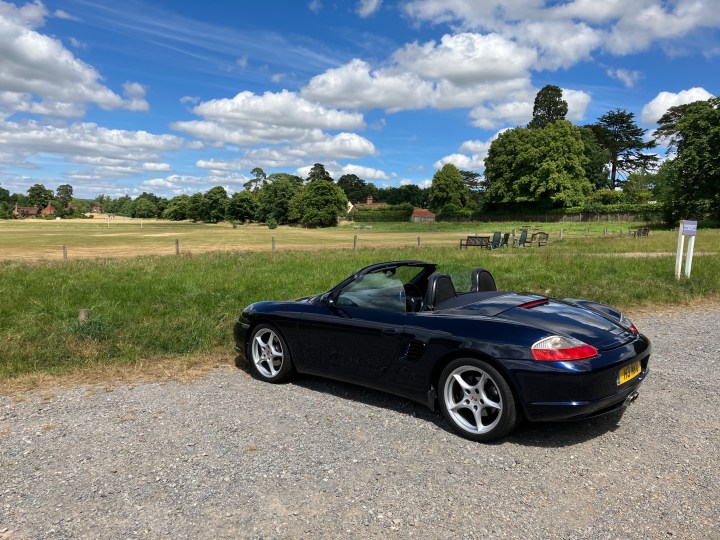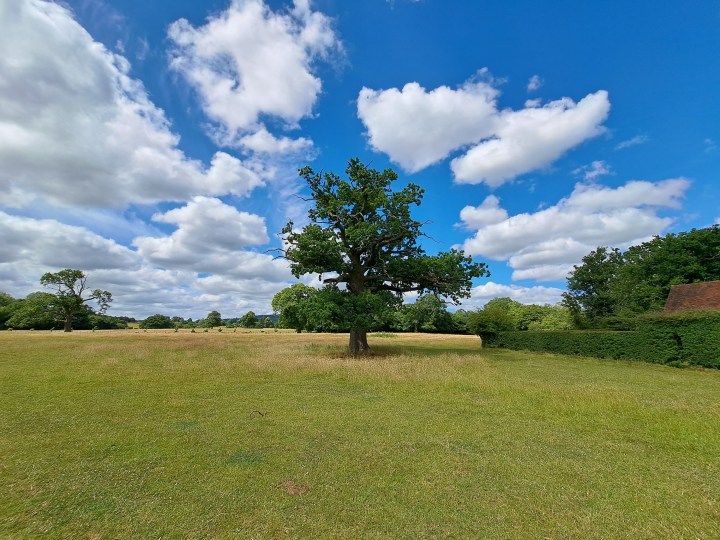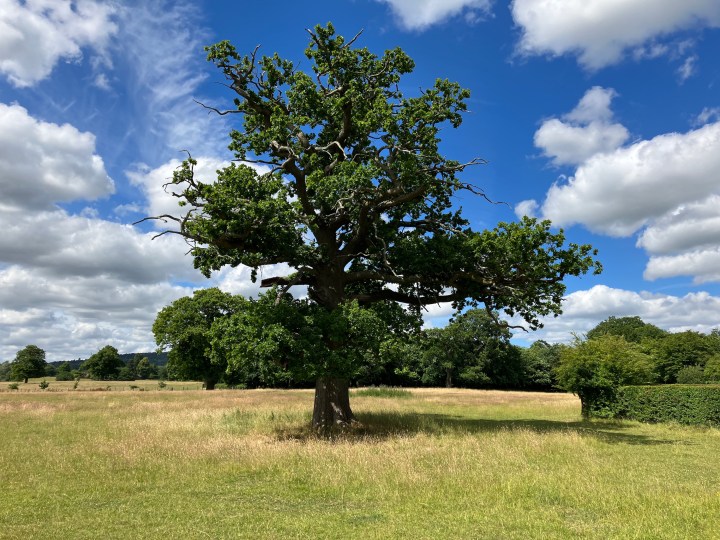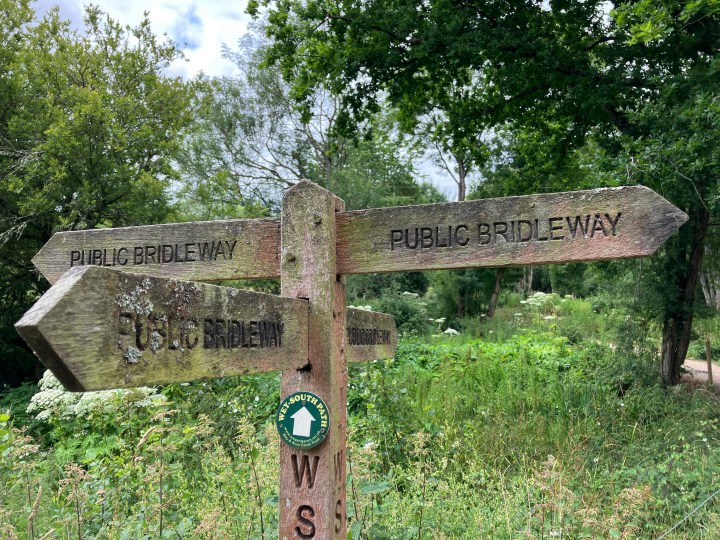The Samsung Galaxy A53 5G has five cameras on the back, the OnePlus Nord 2T has three, the Google Pixel 6 has two, and the Apple iPhone SE (2022) has just one camera. Surely, due to these differences, it would be a very unfair fight to compare them all?
That’s precisely what we wanted to find out! Let’s take a look and see if having multiple cameras on your phone really makes a difference to photo quality, or if those extra sensors are little more than fluff.
The phones and cameras
It may look like the phones in the test aren’t really competing with each other, but if you’ve got somewhere around $500 or 500 British pounds to spend, then these will likely all show up in your search. We’re not going to compare the hardware here, and are instead going to concentrate only on camera performance. To do that, we should first look at the camera specs on each phone before we get to the photos.
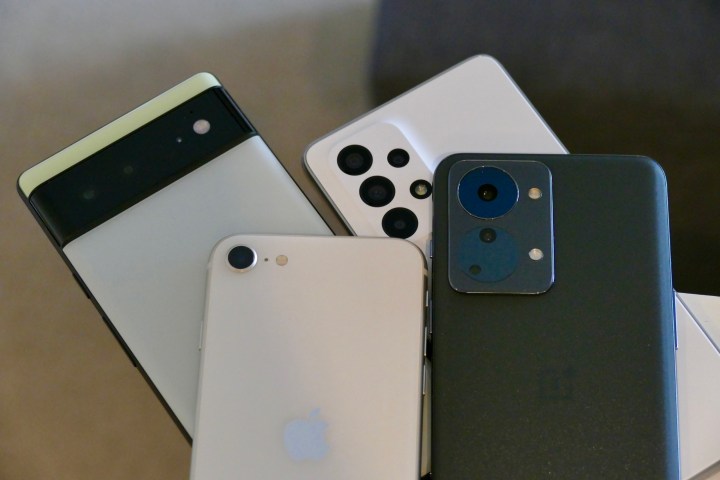
The Galaxy A53 has a 64-megapixel main camera with optical image stabilization (OIS), plus a 12MP wide-angle camera with a 123-degree field of view, and a pair of 5MP cameras for macro and depth sensors. On the front is a 32MP camera, all of which matches the Galaxy A52. On the OnePlus Nord 2T, you get a 50MP camera with OIS, an 8MP wide-angle camera with a 120-degree field of view and electronic image stabilization (EIS), and a 2MP monochrome camera.
While these two contain lots of cameras, the other two contenders make do with fewer cameras. The Pixel 6 has only two, a 50MP main camera and a 12MP wide-angle camera with a 114-degree field of view, plus an 8MP selfie camera. Finally, the iPhone SE (2022) has a single 12MP camera on the back and a 7MP camera on the front.
All the photos were taken handheld using the automatic settings, and all the phones were running the latest software versions at the time. Photos were examined on a color-calibrated monitor, then resized to make them more online-friendly.
Main camera
These two sets of photos were taken on different days, but in generally similar conditions — sunny, but still with some clouds. They set the standard for the test, as all cameras should be able to do a good job of capturing this kind of photo in an attractive, natural way, with few obvious problems and limited reason to edit.
- 1. Samsung Galaxy A53
- 2. OnePlus Nord 2T
- 3. Google Pixel 6
Starting with the photo of the car, the OnePlus Nord 2T’s photo stands out as taking a very different image from the rest. Its darker, grayer, more drab tones don’t capture the atmosphere at all, and colors haven’t been captured very accurately either. The Galaxy A53 goes in the opposite direction, amping up every color it can find for a vivid and exciting photo that ignores reality almost entirely.
The Pixel 6 and the iPhone SE 2022 sit somewhere in-between with far more natural colors. The iPhone SE captures masses of detail, particularly in the ground, while the colors in the Pixel’s photo are far closer to real life. It’s hard to split the two, so let’s move on to the other image.
- 1. Samsung Galaxy A53
- 2. OnePlus Nord 2T
- 3. Google Pixel 6
In the photo of the canal boat, the OnePlus Nord 2T fares a little better in terms of color and balance, but the photo lacks detail compared to the rest, which gives it a lower-quality look even without examining it closely. The Galaxy A53 again pushes up the contrast and saturation, but less detrimentally than before.
It’s only when you put it alongside the Pixel 6’s photo that you see what the scene really should look like. It’s just so well-balanced, with a defined and dramatic sky, a realistic reflection in the water, and plenty of detail. The iPhone SE’s photo comes close, but is hurt by the tighter framing, a consequence of the phone’s camera rather than me changing position. For this reason, the Pixel 6 will get the win here, followed by the iPhone SE 2022, the Galaxy A53, and the OnePlus Nord 2T.
Winner: Google Pixel 6
Wide-angle camera
The iPhone SE (2022) doesn’t have a wide-angle camera, so it’s automatically counted out in this part of the test. The iPhone photo we’ve included was taken with the main camera and is only for reference. The quality of wide-angle cameras at this price isn’t always great, so just how much are you really missing out on?
- 1. Galaxy A53 wide angle
- 2. OnePlus Nord 2T
- 3. Google Pixel 6
The Galaxy A53’s wide-angle camera adopts the same saturated look as the main camera, with bright greens and blues in the photo of the tree, far beyond what we see from the other two phones. The OnePlus Nord 2T again comes with a drab color palette, but worse is the level of detail. Even zoomed out, it doesn’t look great. But when you get closer, the quality is very low, with noise, pixelation, and noticeable edge enhancement.
The Pixel 6 may not have the widest angle here, but the quality of the photo is far beyond the competition. The colors are natural, and there’s a high level of detail too. Zoom in, and you can make out individual leaves on the trees and see the texture of the trunk, elements that are a little obscured in the high-contrast A53’s photo, and entirely missing from the Nord 2T.
It’s the Pixel 6 that takes the win, and based on the lackluster performance from the A53 and poor image from the Nord 2T, is it really that bad the iPhone SE doesn’t have a wide-angle camera? If it was like that of the Pixel 6, great, but that would drive the price up considerably.
Winner: Google Pixel 6
Portrait mode
The iPhone SE (2022)’s portrait mode only works with photos of people, not on objects. The photo included was taken with portrait mode, but as you can see, there is no artificial blur added. There is a pleasing natural bokeh to the photo, though, with the sign nicely isolated in the photograph.
- 1. Samsung Galaxy A53
- 2. OnePlus Nord 2T
- 3. Google Pixel 6
The Galaxy A53 doesn’t do a bad job at first glance, but when you look closely, edge recognition is quite haphazard, and it has kept part of the background between the sign in focus, making it look very artificial. The background blur effect is also very strong. The Pixel 6 also has a strong blur and fails to blur out part of the background. However, the image is very sharp, and edge recognition is good.
The OnePlus Nord 2T isolates the sign extremely well and far better than the others, while edge recognition overall is the best out of all three phones. It’s just a shame the exposure is so odd, but it’s nothing some editing can’t fix. Considering how poorly the Nord 2T has done on the other tests, its success here is a bit of a surprise, but it’s hard to say the photo is “better” than that of the iPhone SE. Since this is a test of the Portrait mode, the OnePlus takes the win, but it’s questionable whether using the mode is preferable to not doing so with the iPhone.
Winner: OnePlus Nord 2T
Zoom
None of these phones have an optical or a periscope zoom, so photos taken zoomed in are digitally created. The iPhone SE doesn’t have a “zoom mode” option in the camera app, but the other three all have a shortcut to digital zoom when you’re taking photos. We manually zoomed the iPhone SE in to match the shortcut provided by the other phones.
- 1. Samsung Galaxy A53
- 2. OnePlus Nord 2T
- 3. Google Pixel 6
These photos were taken to highlight the small wooden owl in the tree trunk, which was a little too far away to capture using the main camera. The iPhone SE does a better job than the Galaxy A53 here, providing more detail, better exposure, and far less noise and pixelation.
There’s little to choose between it and the Pixel 6’s photo, which does reveal a little more detail, but isn’t necessarily the better picture. The OnePlus Nord 2T does a great job by isolating the tree in the photo and exposing the gap in the tree trunk effectively. However, the drab colors hurt the overall image, and although it could be fixed with some editing, the iPhone and the Pixel get it just right.
Choosing between them is difficult, but the Pixel 6 does show more detail in the background and has a pleasing, warm, and natural tone. It’s our winner here.
Winner: Google Pixel 6
Portrait selfie
This is a test to show how each phone not only deals with edge recognition, but also how it interprets skin tone and detail, and all four phones give very different results. The Galaxy A53’s selfie camera provides a very low level of detail, obscuring all the texture of my skin. Edge recognition is also poor, with jagged edges running down my cheek.
- 1. Samsung Galaxy A53
- 2. OnePlus Nord 2T
- 3. Google Pixel 6
The Pixel 6 has a far higher level of detail, but the edge recognition fails to capture the side of my glasses, which is something of a surprise. The OnePlus Nord 2T’s edge recognition is similar to that of the Galaxy A53, but my skin is not quite as ashen as it appears in the photo. This leaves the iPhone SE (2022).
It blurs the background in the lens of my glasses, it isolates my cap effectivity, and my skin tone is far more natural. Zoom in, and there’s plenty of texture and definition in my skin, too, making it the winner here.
Winner: Apple iPhone SE (2022)
Night mode
The iPhone SE doesn’t have a dedicated night mode in the camera app, but automatically switches to a longer exposure when it detects lowlight conditions. All the other cameras do have a separate mode, and each was active for these images. Starting with the iPhone, the image it takes is probably the most attractive, with the glow of the sunset in the distance, and the orange glow of the streetlights matching it.
- 1. Samsung Galaxy A53
- 2. OnePlus Nord 2T
- 3. Google Pixel 6
Zoom in, and you can easily read the names on the memorial, and although there is some noise, it’s not excessive. The Galaxy A53’s photo is full of noise, from the sunset in the background to the memorial and surrounding wall. It’s noticeable even when you don’t zoom in, and doesn’t make the photo very shareable.
The OnePlus Nord 2T’s colors are similar to the iPhone’s, but the photo is ruined due to it smoothing the memorial and wall out to the point where it looks like it’s made of marble. It’s distracting and entirely separate from reality, and there’s some harsh edge enhancement throughout. It’s a shame, as the colors are pleasant. The Pixel 6’s photo is almost noise-free, the text is amazingly sharp, and the night sky has just the right coloration. It comes down to the Pixel and the iPhone.
The Pixel has a high level of detail, accurate textures, and lack of noise, while the iPhone’s sky and sunset are far more beautiful. I’d quite like to mix the two and create the ideal hybrid image. The Pixel 6’s photo is technically superior to the iPhone’s, but I prefer the emotion captured by the Apple phone. It’s a tough choice, but the Pixel’s technical ability gives it the (very close) win.
Winner: Google Pixel 6
Conclusion
There are six categories in all, and the Pixel 6 has won four of them, giving it the overall title here. The iPhone SE (2022) took a single category, as did the OnePlus Nord 2T, but the iPhone SE was a close second. The Galaxy A53 failed to win any categories. Despite winning one category, the Nord 2T performed badly in the tests that really matter — main and wide-angle. Yes, it’s the cheapest phone here, but in those two crucial categories, it’s far behind the competition.
Viewed in isolation, the Galaxy A53’s camera isn’t a terrible performer, and in many circumstances, it takes pretty and very shareable photos. But put it up against the Pixel 6 and the iPhone SE (2022), and its lack of realism sees it suffer, and also exposes problems with its software.
What have we learned here? That having many cameras doesn’t mean it takes better photos, as the Pixel 6 and iPhone SE (2022) regularly battled for wins here, despite having fewer cameras than the other two phones. It also shows that if you want to take great photos without paying up for a flagship phone, the Pixel 6 is a superb choice. And despite having a single camera, Apple’s ability to get the best from the iPhone SE (2022) can’t be ignored.
Editors' Recommendations
- 5 phones you should buy instead of the iPhone 15 Pro Max
- The OnePlus 12 has one big advantage over Samsung and Apple
- How bad is a 2012 iPhone camera in 2023? Take a look for yourself
- I did a Pixel 8 and OnePlus 11 camera test. Picking a winner wasn’t easy
- I tested the Pixel 8 Pro and iPhone 15 Pro. This one has the best camera




